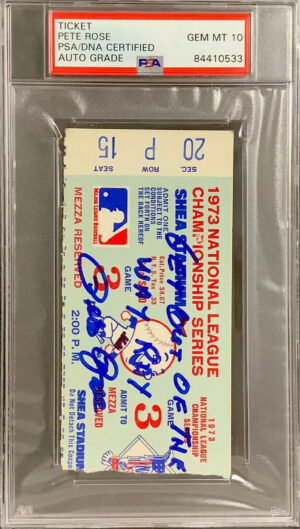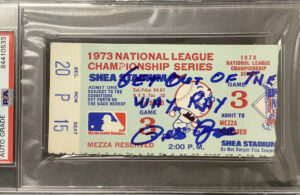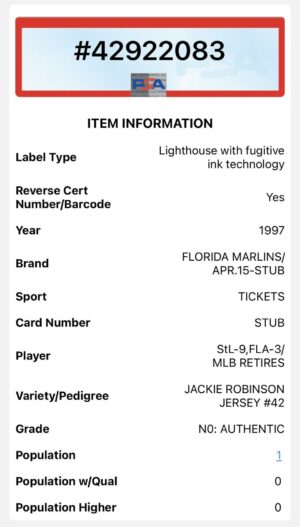Pete Rose Signed NLCS All-Star Ticket (PSA) Graded 10 GEM-MINT
$750.00
Pete Rose Signed Ticket (PSA) Graded 10 GEM-MINT NLCS Game 3 Reds vs Mets.
Pete Rose signed “GET OUT THE WAY RAY” referring to the most famous All-Star game in 1970 when Pete Rose aka Charlie Hustle ran over Ray Fosse like a Mack Truck in the bottom of the 12th inning.
It was over 50 years ago — on the eve of the 41st Major League Baseball All-Star Game in Cincinnati — that Ray Fosse met Pete Rose for the first time.
“I didn’t know Pete at all until the night before the game,” Fosse recalled of the evening he and his Cleveland teammate, Sam McDowell, along with their wives, had dinner at the Rose home. “We met at some function and he invited me over to his house and we sat up half the night talking baseball.”
The next time Rose and Fosse got together — about 24 hours later in the bottom of the 12th inning at Cincinnati’s sparkling new Riverfront Stadium — the meeting wasn’t quite as social.
In one of the most famous plays in baseball history, Rose violently bowled over Fosse at home plate, enabling the sparkplug of the Cincinnati Reds to score the winning run in the National League’s come-from-behind 5–4 victory over the American League.
“I didn’t really know what kind of player Pete was until the next night,” said Fosse, who suffered a shoulder injury and was never quite the same player after the collision. “I never got hit like that before. I know he didn’t mean it, but who knows, maybe he should have run around me. If he had it would have saved me a lot of pain. We both made the plays that we thought we had to make, a couple of aggressive ballplayers doing their jobs.”
Never mind that this was just an exhibition game. Back then, in 1970, the All-Star Game meant something to the players because the National and American leagues were completely separate entities with no interleague play. Each league had its own president, and winning the All-Star Game meant bragging rights at least until the World Series.
So, when Rose came barreling around third, he was going to score that run and if Fosse was dumb enough to block the plate, so be it.
“That’s the only way I know how to play, I play to win, the way my father taught me to play,” Rose said, defending himself that night. “I play hurt, I play tired, I play as hard as hell. Don’t tell me it’s an exhibition or spring training. Don’t tell me to take it easy between the white lines. That’s not me, that’s not my dad. If I play a charity softball game for nothing, not a dime, I go all out. Besides, nobody told me they changed it to girls’ softball between third and home.”
When the NL rallied for three runs in the bottom of the ninth to tie the game at 4–4, Rose struck out with the winning run on first base to end the inning. He had also struck out in his previous at-bat in the eighth. So here was the hometown boy, born and raised in Cincinnati and a member of the Reds, flopping miserably in the All-Star Game in front of President Nixon, 51,838 paying customers at the two-week-old, $45 million stadium, and a national TV audience.
Naturally, Rose was looking to make amends when he dug himself into the batters’ box to face Clyde Wright of the California Angels with two outs in the 12th.
He lashed a single up the middle and moved to second when Bill Grabarkewitz of the Dodgers singled to left. Jim Hickman of the Cubs then lined a 1–0 fastball to center to send Rose off on his mad dash to the plate.
Kansas City’s Amos Otis fielded the ball cleanly and rifled a strong throw that sailed a few feet up the third base line. As Fosse moved out to receive the ball, he straddled the foul line and blocked Rose’s path, leaving Rose — at least in his mind — no alternative.
Just as the ball got to Fosse, Rose lowered his left shoulder and catapulted himself into Fosse’s left shoulder. The catcher went flying backward, losing both the ball and his glove, and before he realized what had happened, Rose had touched the plate and the fans were on their feet gleefully celebrating the fantastic finish.
“I thought I was beat by the throw,” said Rose. “I started to slide head first but I saw I couldn’t make it because he was blocking the plate. If I would have slid I would have been out. The only thing I could do was run him over. I didn’t care about hurting myself if we could win. Look, I’m the winning run in the All-Star Game in my hometown. I just want to get to the plate as fast as I can.”
Now 50 years have gone by and Fosse is still asked about a play that many felt was dirty and should not have happened in an All-Star Game.
“That’s something people will continue to talk about, whether they were alive at the time or watched the video and see the result,” Fosse said. “There have been some harder hits. Just the fact it was an All-Star Game, they always vote on the All-Star game highlights or lowlights and that always seems to be at the top that people talk about.”


























